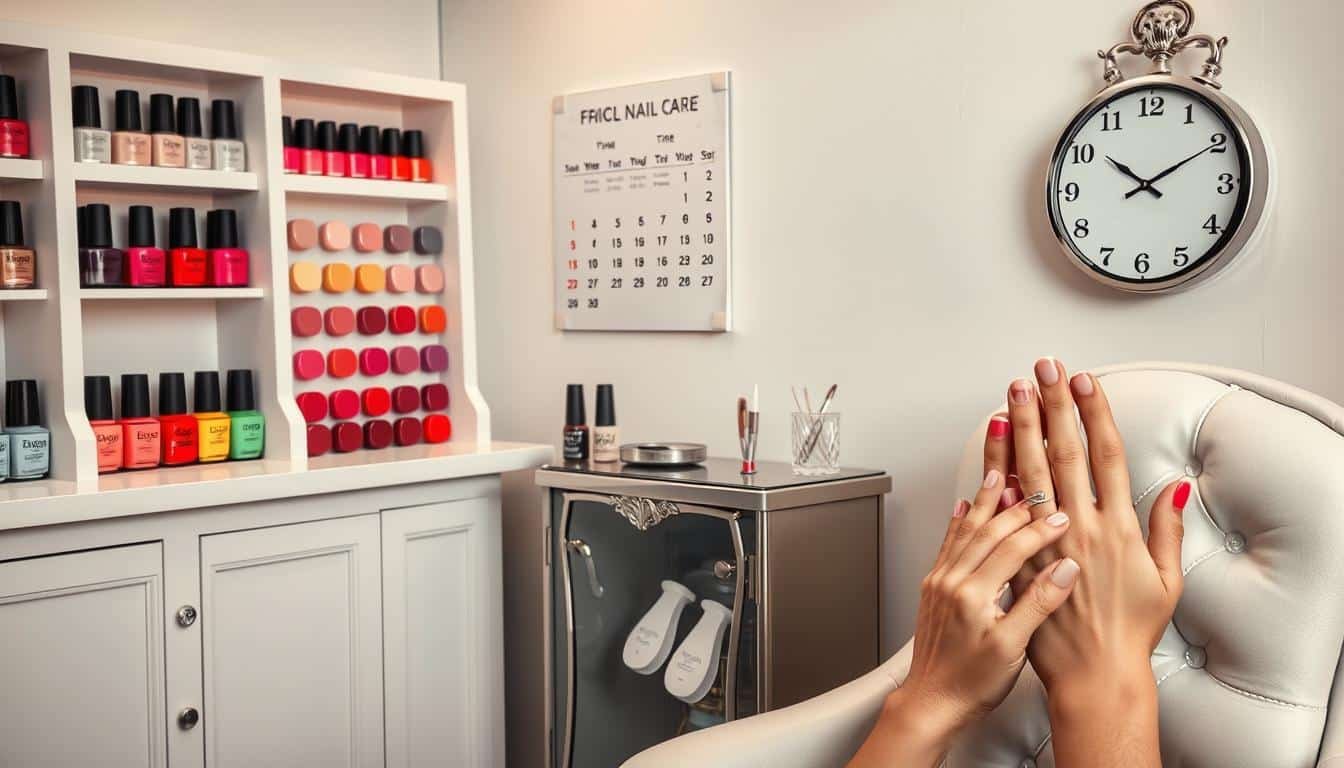Ever thought about if your nail care is up to par? Whether you love salon visits or do it yourself, finding the right nail care frequency can be hard. Let’s explore the best manicure schedule for your nails.
Nail care is more than just a beauty routine. It’s key to personal hygiene and self-care. Your manicure schedule affects your nail health and look. Regular care prevents brittleness and infections, keeping your nails strong and healthy.
There’s no one-size-fits-all answer to how often to get your nails done. Your lifestyle, nail condition, and preferences matter. Some prefer bi-weekly visits, while others go monthly. Let’s look into nail care frequency to find the best schedule for you.
Key Takeaways
- Nail care frequency varies based on individual needs and preferences
- Regular manicures contribute to overall nail health and appearance
- Most people opt for salon visits every 2-4 weeks
- At-home maintenance can supplement professional nail care
- Over-manicuring can lead to nail damage and brittleness
- The type of manicure affects how often you should get your nails done
- Consider factors like job type and nail condition when planning your manicure schedule
Understanding the Importance of Regular Nail Care
Regular nail care is key to keeping your nails healthy and looking good. Professional nail services offer many benefits that go beyond just looks. Let’s look at why keeping up with nail care is important for your nails’ health.
Benefits of Professional Nail Maintenance
Professional nail services give expert care that’s hard to do at home. Nail technicians use special tools and methods to trim, shape, and buff your nails. This helps your nails grow right and prevents them from splitting or breaking.
Going to a nail salon regularly also keeps your cuticles healthy. This reduces the chance of hangnails and infections.
Impact on Nail Health and Appearance
Regular nail care greatly improves your nails’ health and looks. Professional treatments feed your nail beds, making your nails stronger and healthier. They also fix common problems like dryness and brittleness.
With regular care, your nails become more durable and less likely to get damaged.
Preventing Nail Issues and Infections
One big plus of regular nail care is stopping nail problems and infections. Professional nail services keep things clean, cutting down the chance of fungal and bacterial infections. They also stop issues like ingrown nails, which can hurt and cause bigger problems if not treated.
| Nail Care Frequency | Benefits | Recommended For |
|---|---|---|
| Every 2-3 weeks | Optimal nail health, maintained appearance | Most clients |
| Weekly | Therapeutic benefits, pristine appearance | Those with demanding lifestyles |
| Monthly | Basic maintenance, cost-effective | People with naturally healthy nails |
The right nail salon visit frequency depends on your needs and lifestyle. Talk to a pro for advice on the best nail care plan for you.
Factors Influencing Nail Care Frequency

Your nail care routine depends on many factors. Knowing these can help you find the best schedule for manicures and pedicures.
Nail growth rate is key. If your nails grow fast, you might need more visits to the salon. For some, this means going every 1-2 weeks for a new look.
Your lifestyle also affects your nails. If you work with your hands or are often in water or chemicals, your manicure won’t last as long. On the other hand, those with less hands-on jobs might see their manicures last longer.
The type of nail you have also matters. Gel or acrylic nails can last 3-4 weeks, while traditional polish chips faster. Your natural nail strength and health also play a role in how often you need professional care.
| Nail Type | Average Duration | Recommended Care Frequency |
|---|---|---|
| Traditional Polish | 1-2 weeks | Every 1-2 weeks |
| Gel Manicure | 2-3 weeks | Every 2-3 weeks |
| Acrylic Nails | 3-4 weeks | Every 3-4 weeks |
| Dip Powder | 3-4 weeks | Every 3-4 weeks |
For pedicures, experts suggest going every 4-6 weeks. This helps keep your feet healthy and looking good. Toenail growth rate and how active you are can change this time.
What you like and how much you want to spend also affects how often you get nail care. Some like to go weekly for a polished look. Others prefer to go less often.
How Often Should You Get Your Nails Done?
Your nail appointment frequency depends on your lifestyle and preferred nail treatments. Let’s look at the recommended schedules for different nail services. This will help you plan your manicure and pedicure routine.
Recommendations for Standard Manicures
For standard manicures with regular polish, visit your nail salon every one to two weeks. This keeps your nails looking good and in shape. Beauty experts recommend getting a manicure and pedicure every two to three weeks for the best nail health.
Frequency for Gel and Dip Powder Manicures
Gel and dip powder manicures last longer. Plan to get these treatments every two to four weeks. This lets you schedule your salon visits more easily.
Pedicure Scheduling Guidelines
Your pedicure routine can be less frequent than manicures. Try to get a pedicure every four to six weeks in colder months. In sandal season, you might want to get a pedicure more often to keep your feet looking great.
| Service | Recommended Frequency | Price at Beauty Schools |
|---|---|---|
| Basic Manicure | 1-2 weeks | $8 |
| Gel Manicure | 2-4 weeks | $15 |
| Basic Pedicure | 4-6 weeks | $15 |
| Gel Pedicure | 4-6 weeks | $18 |
Remember, these are just guidelines. Adjust your routine based on your nail growth and personal preferences. Regular manicures and pedicures not only look good but also keep your nails healthy and prevent infections.
Signs It’s Time for a Nail Appointment
Your nails can tell you a lot about your nail health. Look out for chipping or peeling polish. This means it’s time for a manicure.
Visible growth at the cuticle, about 3-5mm per month, is another sign. Also, rough edges or dry cuticles need professional help.
Keeping your hands beautiful is important. If your nails become brittle or break easily, it’s time for a treatment. Discoloration or texture changes are warning signs.
For those with gel or dip powder, growth of more than 1/3 of the nail is a sign for a new application.
Regular visits to your nail tech are essential. Women usually go every 4 weeks. But, if your nails grow fast, you might need to go more often.
For weaker nails, filing and shaping every 2-3 weeks can help. Consistent care leads to healthier, more beautiful nails.
FAQ
What are the benefits of regular nail care?
How often should I get a standard manicure with regular nail polish?
How long do gel and dip powder manicures last?
How frequently should I get a pedicure?
What factors determine how often I should get my nails done?
What are signs that indicate it’s time for a nail appointment?
Source Links
- How often do you get your nails done? | Mumsnet – https://www.mumsnet.com/talk/style_and_beauty/2406454-How-often-do-you-get-your-nails-done
- How Often Should You Take a Break From Acrylic Nails? – https://www.isdin.com/us/blog/beauty/how-often-should-you-take-a-break-from-acrylic-nails/
- How Often Should You Get Your Nails Done? – https://someofthisandthat.com/how-often-should-you-get-your-nails-done/
- Nail Care Routine: A Beginner’s Guide – https://www.londontownusa.com/blogs/londontown-blog/nail-care-routine
- How Often Should I Get a Manicure? – PURE NAILS – https://purenailsmadison.com/how-often-should-i-get-a-manicure/
- How Often Should You Get a Manicure and Pedicure • Christina All Day – https://christinaallday.com/manicure-and-pedicure/
- How Often Should You Get a Manicure in Lusail? – Diva Salon – https://divasalon.qa/often-get-manicure-lusail/
- The Benefits of Manicures and Pedicures | Houston Training Schools – https://houstontrainingschools.net/benefits-of-manicures-and-pedicures/
- How Often Should You Be Getting Beauty Treatments Done? Here’s Your Handy Calendar – https://www.bustle.com/p/how-often-should-you-be-getting-beauty-treatments-done-heres-your-handy-calendar-30670
- How Often Should You (Really) Get a Manicure | Jumana Saloon – https://jumanasaloon.ae/how-often-should-you-really-get-a-manicure/
- How Often Should You Get Your Nails Done? – https://www.swaynails.ca/blog/how-often-should-you-get-your-nails-done?format=amp








Why obsess over nail care? Not everyone has the time or money for this. Natural nails can be healthy & beautiful too.
So, what if I like my nails gnarly and natural? Isnt over-grooming a sign of vanity? Just food for thought, folks.
Interesting read, but isnt obsessing over nail care just vanity? Isnt healthy living more important than regular manicures? Just food for thought.
Interesting read, but arent we promoting vanity over health here? What about those who prefer natural nails? Food for thought, eh?
So, if I chew my nails to oblivion, does this whole regular nail care thing still apply? Asking for a friend.
Interesting read, but isnt obsessing over nail care feeding into superficial beauty standards? What about inner beauty and self-acceptance? Just a thought.
Interesting read, but arent we neglecting the environmental impact of nail products? Cant we embrace natural nails and care less about appearance?
Anyone else think this obsession with constant nail care is a bit excessive? What happened to just clean, healthy nails?
Interesting read but isnt this promoting vanity over health? Arent there more important things than obsessing over nail appearances? Just a thought.
Health doesnt negate vanity. They co-exist. Why not look good while being healthy?
Interesting read but honestly, who has time for weekly manicures? Isnt embracing natural beauty more important these days? Just food for thought.
Is it just me or is this obsession with regular nail care a bit overrated? How about focusing on inner beauty, eh? Just a thought.
Perhaps inner beauty thrives more when outer self-care isnt neglected. Balance is key, dont you think?
I disagree slightly. Who says we need professional care? My grandmas been maintaining her nails herself for 90 years! Lets be real here.
Well, not everyone is as lucky or skilled as your grandma, mate!
Interesting read, but isnt obsessing over nail care feeding into vanity and consumerism? Lets prioritize health over aesthetics, dont you think?
I reckon this is overrated. Ever thought about the environmental impact of all these nail products? #SustainableBeauty is the real trend.